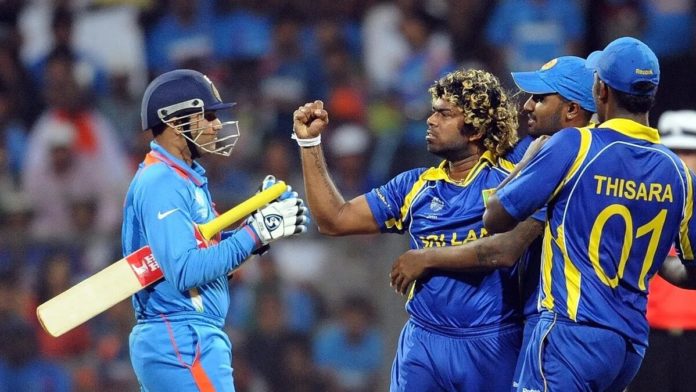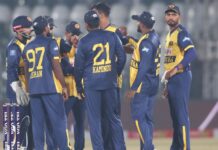The 2011 World Cup final between Sri Lanka and India will remain a conspiracy theorists’ beehive, a cricket fan’s conundrum, more than any of the above it will remain a wound that will fail to heal and hurt equally the same even after almost a decade.
Free Hit Contributor – Aravinthan Arunthavanatha
On the 2nd of April this year, during the height of lockdown, the game was re-telecast on Star Sports. Being a cricket tragic who would happily wake up in the middle of the night to watch a dull test match in the opposite corner of the world and then go about the following day without any regret, on seeing the advertisement, I made a note on my calendar to watch this telecast.
I was curious to see why Dilshan and Tharanga couldn’t get off to a decent start, why Mahela and Sanga couldn’t tick the scoreboard over in the middle overs as they normally do, why our middle order collapsed when it mattered the most, why we let Gambhir and Kohli off the hook after that roaring start… and so on.
There were so many “Why?”s for which I was desperate to find answers even after nine long years. When that Dhoni six was replayed almost a decade later, the pain was phenomenal. The emptiness seemed to be eternal. Time didn’t seem to heal this wound. I thought to myself that it was just for me, probably not for others who have better things in life than thinking and writing about a game that happened a decade earlier.
At least that’s what I thought to myself until I saw the backlash the recent match-fixing allegations created. The feeling is universal, it hurts every Sri Lankan fan to date. It hurts, even more, to think that some consider foul play was involved.
Now let’s get to the topic. Was it fixed or not? That will be a question that will never find everyone agreeing upon. Even though I believe it was not influenced, there is still a conspiracy theorist within me who would pose the question “why did the shoulders drop when in a position of strength?”, “why was the usual energy lacking in Sangakkara long before the game was gone?”.
These are a few things I could vividly remember from the game. Even in the repeat telecast, it was obvious. Maybe it was just that the dew was starting to fall, maybe it was just that the team realized Murali was nowhere near his best, maybe the team realized the bowling lacked bite in the given conditions. Those are speculations which will never find a concrete answer. Nevertheless, what can cricketing logic unravel about the common concerns regarding selection, toss, and the flow of play?
Cricketing logic does defy the myths that surround this monumental game, if you approach it with a rational mind. There have been so many misinterpretations, many of which were dispelled by past cricketers during this lockdown period through various media. This article intends to dissect the game for what it was and reason out why we should move on and why it is irrational to think the game was fixed.
To start off, momentum plays a key role in any campaign. Going into the final India were coming off two high pressure games which they won from positions they could have lost against Australia and Pakistan. Against Australia, when Dhoni departed leaving a run a ball chase to Yuvraj and Raina, it was anybody’s game.
The pair saw India home. At Mohali in the Semis, a middle-order collapse left India reeling. Raina pulled them out into safe waters again which was followed by a clinical bowling effort. Those were two high octane games where India earned their wins. Their batting line up was tested, the bowlers too had to deliver under pressure.
India were a battle-hardened unit functioning as a well-oiled machine. They had massive momentum. Sri Lankans would have wished India were on cloud nine walking complacently into the finals. With a leader like Dhoni, it was never going to happen. An encore of 1996 was not on the cards.
Sri Lanka on the other hand faced the English and Kiwis on dust bowls in Colombo. Conditions Sri Lanka would take any day of the week. The Kiwis and English were nowhere close to India and the Kiwis upsetting the Proteas in hindsight deprived us of a challenging battle in the Semis which may have held us in good stead for the finals. Sri Lanka romped home against England by ten wickets. But the reality was that the batting line up wasn’t tested. The Kiwi game too wasn’t different. Most of the work was done by the top order until an unnecessary middle order collapse infused some tension till Mathews ensured a national calamity was avoided. But this phase would have a significant impact in the run up to the finals as we would see later.
It was a tournament where you had to get into the knockouts and win three on the trot to be champions. It wasn’t Sri Lanka’s fault that they had it easy. But in reality, the Indian juggernaut had gained momentum. Momentum makes things happen. It’s the belief teams have in themselves that they can win from any position. India had done it twice whereas Sri Lanka wasn’t forced into such situations.
The teams were equally matched, make no mistake about it. But the magical momentum was with India. Sri Lanka had to punch above their weight to have a favorable outcome. However, the injury to Mathews in the semis dealt a killer blow, not only to the balance of the team but to Sri Lankan chances as well. This was a major factor in deciding the composition of the team for the finals.
Sri Lanka have been traditionally a team that follows the principle of “don’t fix it if it ain’t broken”. There have been many such instances in the years prior where passengers have been carried just to go with the winning team. In this context, four changes going into the final was a recipe made for controversy.
However, when looking at those changes from a cricketing perspective, they made absolute sense. Mumbai and Colombo were entirely different tracks. While Colombo had spin, Mumbai was more a batsman’s paradise with bounce on offer.
With Mathews out Thisara was obviously the like for like replacement despite being new in the side. Thisara was more of a bowling allrounder, who had a decent record against India. He had in fact dished out a five-wicket haul in Dambulla in 2010 against the same opponent.
Further Sri Lanka had gone in with three frontline spinners in the semis given the weakness of the Kiwis. Against India it was obvious, one of them had to be replaced by a fast bowler. A three-pronged spin attack was never an option against India.
Kulasekera was Sri Lanka’s reliable new ball bowler by then who had held the number one rankings in ODIs as well. Kulasekara instead of Herath over Dilhara Fernando was a no brainer because Dilhara hadn’t been comfortable opening the bowling throughout his career.
However, the change that caught the attention of many and gave rise to speculations was Suraj Randiv coming in instead of Ajantha Mendis. As irrational as it may sound, many wouldn’t remember Randiv was far better against India in this period compared to Mendis. After his initial burst to fame in 2008/09 Mendis was decoded by India and Pakistan and wasn’t much of a threat anymore.
This is backed by numbers. In the years 2009/10 Mendis had played 10 games against India and had picked up 10 wickets at an average of over 50 and an economy of 5.7. Randiv on the contrary had played 13 games, picked up 12 wickets at an economy of 4.6 and an average of roughly 45. Anybody who followed the game at that time would agree Randiv was by far the best choice against India with an impressive track record.
His height and bounce on the Mumbai track was an added advantage. As much as it may look fishy bringing in a player from outside the squad, this selection made absolute sense in cricketing terms. Mendis was a marvel against mediocre teams but mediocre against the masters of spin. It is also imperative to note, Herath on the other hand had played only a solitary ODI against India in that period in 2010 and wasn’t an established bowler in limited-overs cricket.
2011 World Cup Final ‘match-fixing’ controversy revived by former Minister
The final swap of Chamara Kapugedera for Chamara Silva was one made out of desperation. Silva’s painstakingly laborious 13 off 25 in the semis when the game was all but taken was good enough reason to go for Kapugedera as Silva hadn’t found his form throughout the tournament. This change was in fact a proactive move that was quite uncommon in Sri Lankan selection processes back then and even now.
In hindsight when one contextually interprets the changes that were made with cricketing rationale it isn’t as suspicious as it may seem on the surface. Even without Angelo’s injury, Sri Lanka would most likely have made three changes. This flux in team composition led to another controversial decision. The toss.
The reality regarding the toss was that the team was divided on what to do on winning the toss. Murali has openly said Sri Lanka should have chased. Sangakkara on the other hand has rationalized his choice in many interactions on social media during this lockdown. However, if we dive into the tournament proceedings prior to that, there are a few important considerations that provide insight.
The only instances where India failed to win games in that tournament were when they batted first. In both instances, against the English in Bengaluru and Proteas in Nagpur, the Indian middle-order had collapsed following fabulous starts. Yet they posted very competitive scores on both instances. However, the weakness in the bowling was exposed while defending those targets.
Apart from Harbhajan and Zaheer, the rest were vulnerable. This should have been a good enough reason for Sri Lanka to chase. However, in the game against Pakistan and also against New Zealand in the semis, the Lankan middle-order did not look convincing. With Angelo’s absence, the middle order was brittle to say the least.
The middle-order had not done anything of note in the lead up to mount a solid case for chasing. Sri Lanka struggling to score the last 60 runs losing 5 wickets in the semis was a glaring example of how undercooked the middle order was. Samaraweera at five and Kapugedera at six were too much of a chance to fancy a chase. It was a matter of balancing between trying to exploit the weakness of the opponent while covering our weakness. It was a delicate balance. Nevertheless, bowling was Sri Lanka’s strong suite. With Malinga and Murali in the attack, it was quite logical to have chosen to defend.
The other factor to consider was the dew. Though there was dew in the group game against the Kiwis, Sri Lanka adhered to the age-old principle of leaving the uncontrollable out of the equation. Dew belonged to that category and it was quite right not to base the decision on an uncontrollable. In retrospect it may seem foolish to have ignored the dew threat but logically in the lead up to final Sri Lanka took the rational path. The threat of changing the dew was better than risking a weak middle order.
From the above, it’s quite obvious that most of the glaring facts that grab the attention were in fact quite rational and make cricketing sense. These are valid enough to dispel the conspiracy theories that have floated around forever.
It may be hard for the common fan to accept that a score of 274 was inadequate. But in reality it was just a par score. The dynamic opening pair of Tharanga and Dilshan struggled to get off to the fliers they were used to. Mahela and Sangakkara, though managing to forge a partnership, were throttled by the Indian spinners. It was Thisara’s cameo and Mahela’s late surge that propelled the score to a respectable level.
Malinga’s brilliance at the onset dealt two massive blows which skyrocketed Lankan hopes. But the reality was that except maybe for the last 10 overs in the Sri Lankan innings and the first 10 overs of the Indian innings the rest of the game was dominated by India. They were never out of it at any point. Both Gambhir and Kohli stitched a decent partnership at a decent rate from where Dhoni closed the game. It was truly an all-round performance by the Indian team. (This is supported by impact index analyses of the final which have been published. Since that statistical analysis is beyond the scope of this article it will not be dealt with. Anyone interested can access them on the @Cricviznalaytics twitter handle on 02nd of April 2020)
It’s hard for the Sri Lankan fans to accept it. But the reality is the better team that won on the day.
The trajectories of both nations which once shared a great rivalry has diverged ever since. India went north and Sri Lanka went south. A win in 2011 wouldn’t have made a difference at all. In fact, it’s time for us to move on from a mythical bubble and come to terms with reality.
*Disclaimer: The views and opinions expressed in this article are those of the author’s and do not necessarily reflect the official policy or position of ThePapare.com.
If you have an opinion on Cricket – you get a Free Hit here. Write to [email protected] to be featured!














